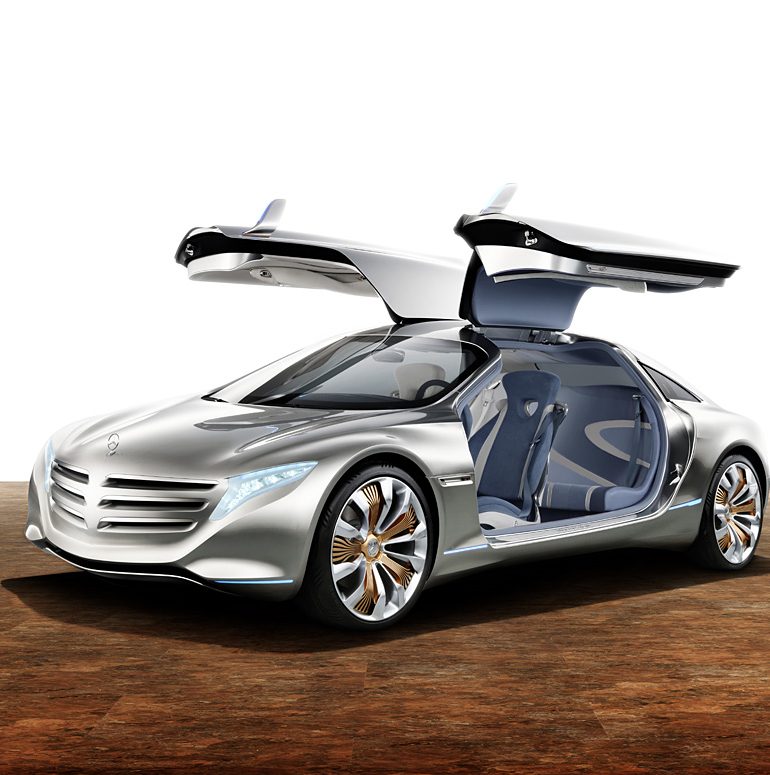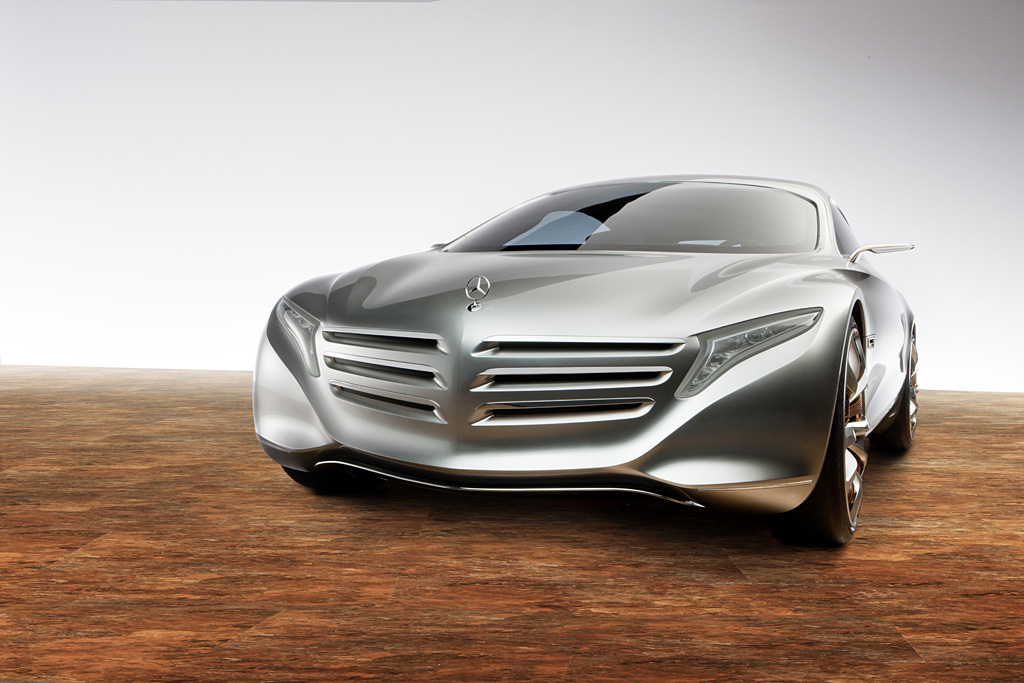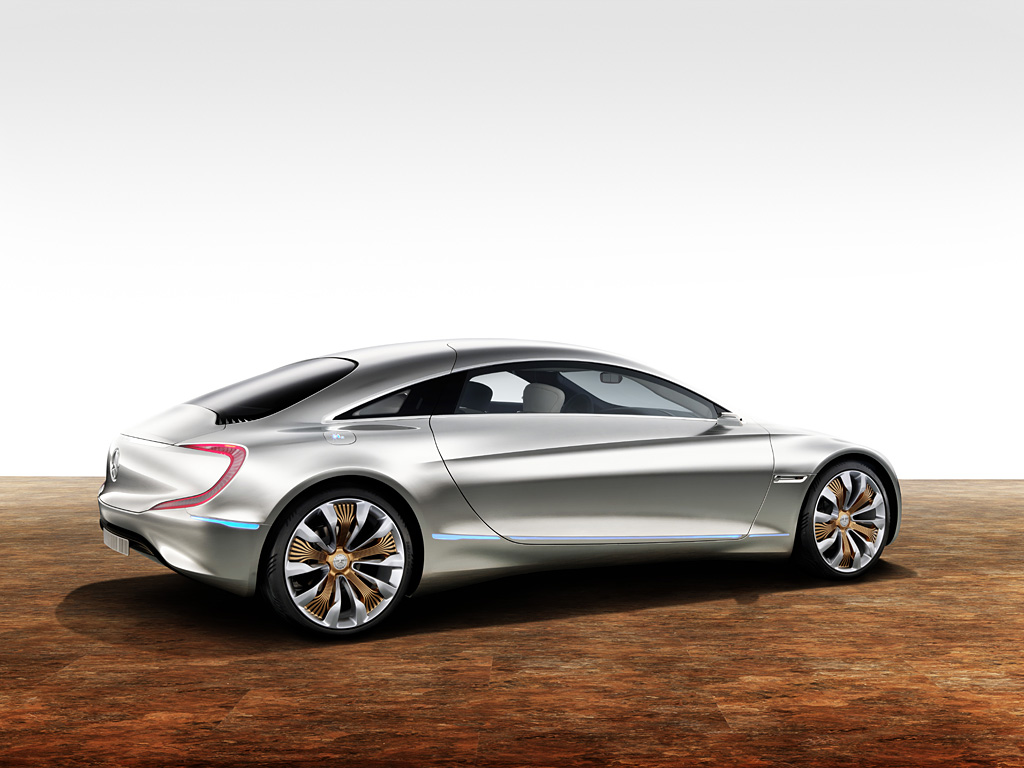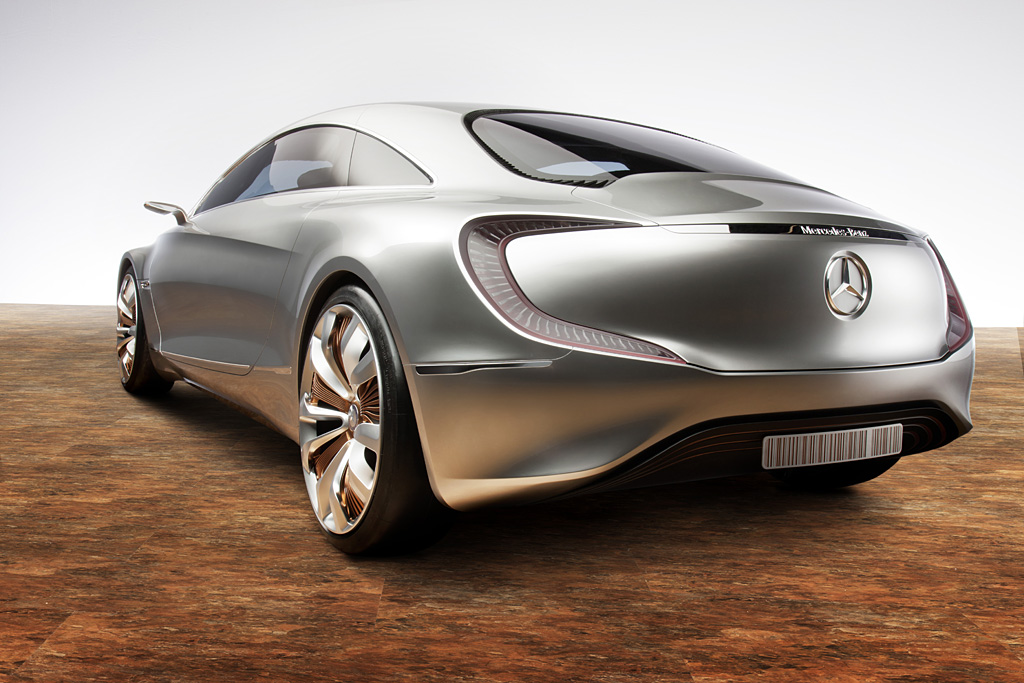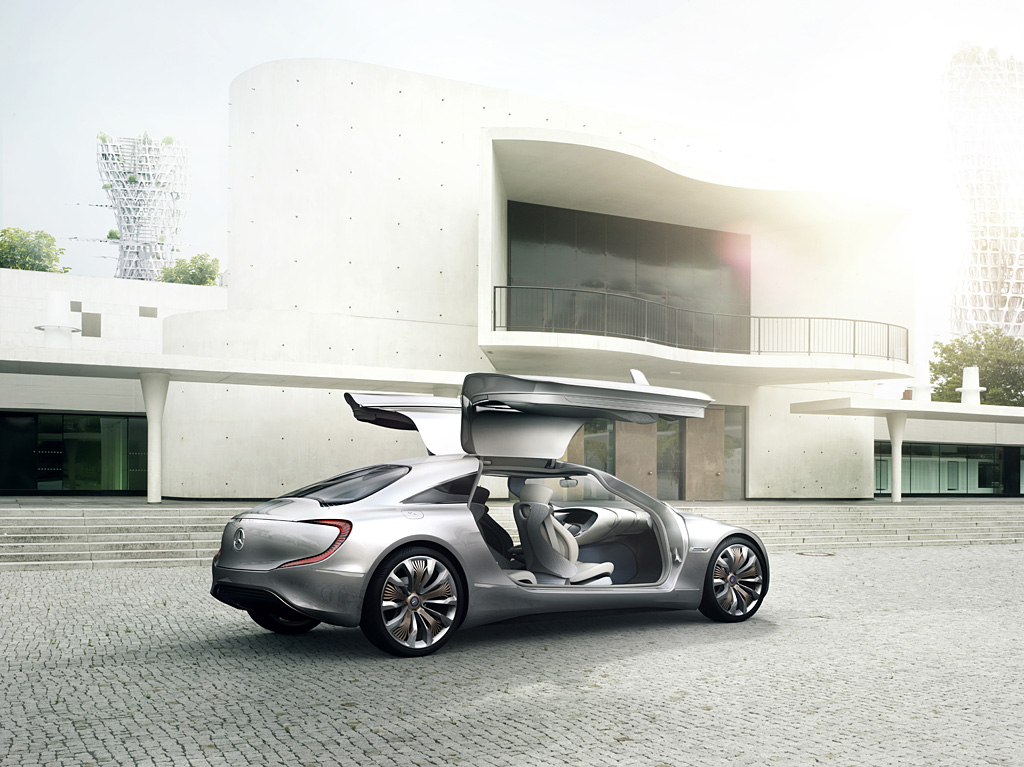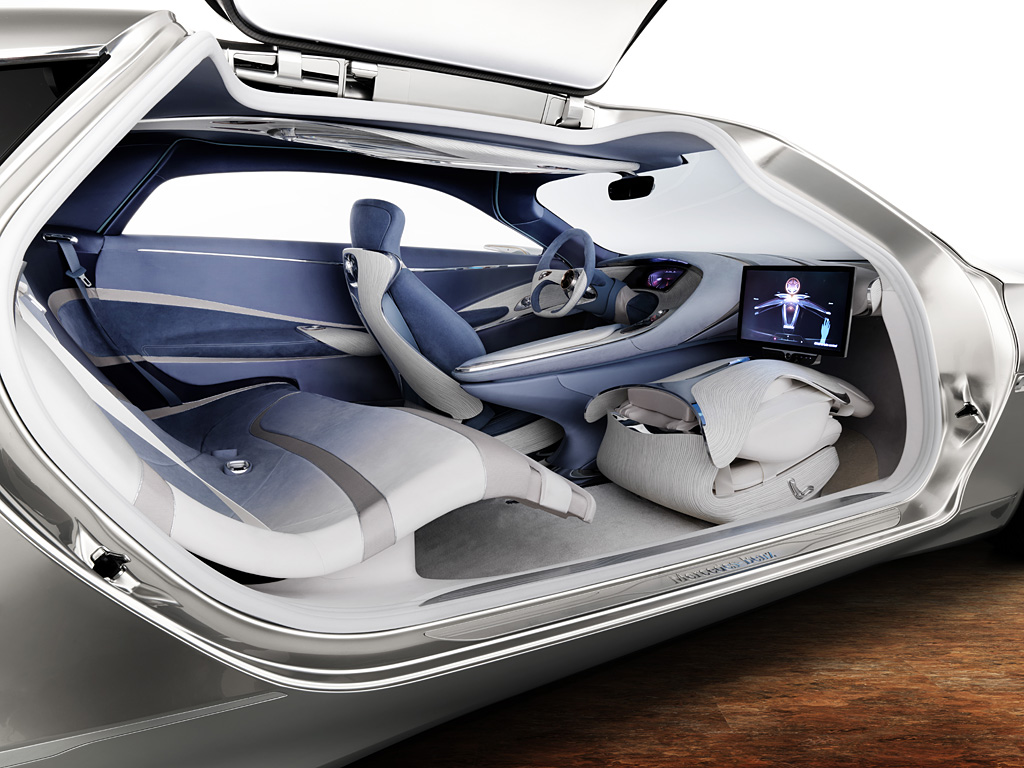2011 Mercedes-Benz F 125!
As a highlight marking 125 years of the automobile, Mercedes-Benz is presenting a visionary outlook on future technical developments in the luxury segment. The F 125! research vehicle anticipates future trends and prepares the way for implementation of an innovative premium concept for large, luxurious automobiles.
In the F 125! Mercedes-Benz rigorously follows its vision of emission-free driving with hydrogen power, underlining the potential of H2 as an energy source for the future. While previous Mercedes-Benz research vehicles have “looked ahead” by roughly one vehicle generation – seven to eight years – the F 125! as the latest technological visionary goes a whole step further, by more than two generations to the year 2025 and beyond.
“With the F 125! we want to show that large, comfortable and safe saloon cars have an excellent future, partly because they are able to operate with no emissions. The legend that is the S-Class will continue into the future thanks to intelligent solutions that always have the customer’s needs in mind,” says Prof. Dr. Thomas Weber, member of the Board of Management of Daimler AG, responsible for Group Research and Mercedes-Benz Cars Development. “The new research vehicle illustrates and underlines this claim to leadership with innovative ideas and traditional Mercedes strengths in the areas of design, safety, comfort and performance.”
Innovative ideas
The F 125! demonstrates how completely emission-free, individual mobility might be realised in the luxury segment in the future. The researchers and developers at Mercedes-Benz have incorporated already well-proven concepts and technologies which are not yet available today, but for which basic research has shown great future promise, and therefore a realistic chance of implementation in future series-production cars. The decisive innovations are:
*A logical further development of the fuel cell drive system in combination with plug-in technology
*Revolutionary tank technology: the structure integrated hydrogen composite storage unit.
*Lighter and more powerful batteries, in this case based on lithium-sulphur technology, which Mercedes-Benz is examining in parallel with further development of the current lithium-ion battery and research into lithium-air technology.
On this basis the F 125! was created as an innovative four-seater luxury saloon with a powerful, emission-free electric drive system based on the fuel cell technology developed to series production maturity by Mercedes-Benz. This study combines pioneering and highly efficient storage, drive and bodyshell technologies with unique control and display concepts. The research vehicle also presents itself with an expressive design which transfers the classic Mercedes design idiom into the future.Highlights of the F 125!:
*Completely emission-free mobility with a range of up to 1000 kilometres, full day-to-day suitability, superior performance and first-class comfort.
*A bodyshell of innovative, lightweight hybrid construction with a high proportion of fibre-reinforced plastics and an intelligent mix of carbon-fibre, aluminium and high-strength steels, which allows a significant weight reduction while offering a further considerable improvement in safety. A high-strength construction with crash-responsive protective systems within the doors allows the omission of B-pillars, as well as the use of wide gull-wing doors which allow convenient access to the four seats. In this way the Mercedes-Benz safety philosophy and in particular the decisive principle of the rigid passenger cell developed by Béla Barényi in 1952 are being concertedly taken forward for the future of individual mobility.
*A high-voltage lithium-sulphur battery with a specific energy density of 350 Wh per kg at cell level, which allows considerably higher recuperation rates in combination with the e4MATIC all-wheel drive.
*A control and display concept based on touch, speech and hand-gestures makes the F 125! a true “companion” with whom the driver is able to interact flexibly and effortlessly. The gull-wing doors of light-weight CRP construction can also be opened and closed by hand-gestures.
*Highly attractive displays using 3D and projector-beam technology to open up new visual possibilities.
*Next-generation, substantially networked telematics allow internet-based voice control, integration into social media and extensive remote control of vehicle settings and entertainment functions.
*Innovative assistance systems for lasting driver stress relief, e.g. Advanced Driving Assist for semi-autonomous driving.
*Trailblazing exterior and interior design based on a completely new saloon architecture.
integrated hydrogen composite storage unit
To store the hydrogen as the fuel of the future, Mercedes engineers adapted a technology which is still the object of basic research. This opens up completely new perspectives with respect to the vehicle architecture and operating range. “The structural integrated hydrogen composite unit of the F 125! represents a real technological revolution, as it allows the hydrogen tank to be fully integrated into the bodyshell structure for the first time. In the future, vehicles with emission-free fuel cell drive systems could achieve the operating ranges of current diesel models with no loss of interior space,” says Prof. Dr. Thomas Weber. Based on the current level of know-how, Mercedes specialists consider it possible that they may develop this technology to series production level from 2025.
The tank integrated into the floor assembly has a capacity of around 7.5 kg of hydrogen. Compared to the high-pressure tanks in use today, the H2 tank potentially requires less installation space. This is because to withstand a pressure of up to 700 bar, current tanks need to be cylindrical in shape, and owing to this round cross-section there are inevitably “cavities” between tanks installed next to or above each other. In contrast, tanks that can be filled at a pressure of 30 bar or less can be better integrated into the bodyshell. At the same time they are able to act as “structural” components.
Lithium-sulphur battery: compact and powerful
A highly advanced, very powerful lithium-sulphur battery is envisaged for the F 125!. It has a storage capacity of 10 kWh and is installed behind the rear seats. Combining the fuel cell drive system with the innovative lithium-sulphur battery makes a total operating range of up to 1000 km possible, of which up to 50 km can be under battery-electric power alone. It can be inductively charged at “intelligent” charging stations, and the convenient charging process can be monitored by smartphone. When designing the F 125!, the developers worked on the assumption that by the time of its introduction into series production, this battery type will be capable of energy densities up to 350 Wh per kg. This would represent roughly a doubling of current performance. The real potentials of this technology are however the subject of basic research, and are still difficult to assess at present.
fuel cell as an energy source
At the heart of the drive system lies a particularly powerful further development of the Mercedes-Benz fuel cell stack which has demonstrated its efficiency and day-to-day suitability e.g. in the successful B-Class F-CELL World Drive this year.
On 29 January, marking the 125th birthday of the automobile, Mercedes-Benz commenced the first circumnavigation of the globe with fuel cell powered electric cars in Stuttgart – covering more than 30,000 kilometres on four continents and through 14 countries. The three fuel cell powered B-Class cars and their backup vehicles returned safely to Stuttgart 125 days later.
The stack in the F 125!, which is further improved with respect to performance, consumption and practical suitability, provides the power for four powerful electric motors installed near the wheels, which ensure sporty, superior performance figures. All in all the modular e4MATIC system, which also uses improved drive components from the SLS AMG E-CELL, generates a continuous output of 170 kW (231 hp) and a peak output of 230 kW (313 hp).
This accelerates the F 125! to 100 km/h in 4.9 seconds, with a top speed of 220 km/h. Nonetheless, NEDC fuel consumption is only 0.79 kilograms of hydrogen per 100 kilometres (= 2.7 litres diesel equivalent).
In Detail
| tags | f125 |
| submitted by | admin |
| type | Concept / Prototype Car |
| released at | 2011 Frankfurt Motor Show |
| power | 230 kw / 308.4 bhp |
| torque | 550 nm / 405.7 ft lbs |
| front wheels | F 58.4 x 19.1 cm / 23 x 7.5 in |
| rear wheels | R 58.4 x 19.1 cm / 23 x 7.5 in |
| wheelbase | 3333 mm / 131.2 in |
| length | 4998 mm / 196.8 in |
| width | 1980 mm / 78.0 in |
| height | 1430 mm / 56.3 in |
| top speed | ~220 kph / 136.62 mph |
| 0 – 100 kph | ~4.9 seconds |
| emission | 0 g/km |


